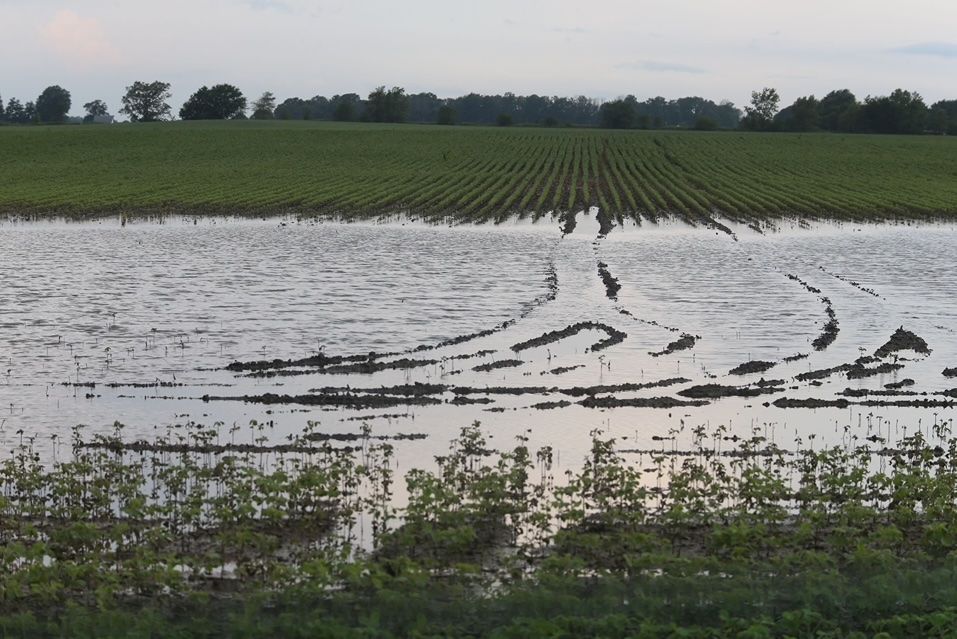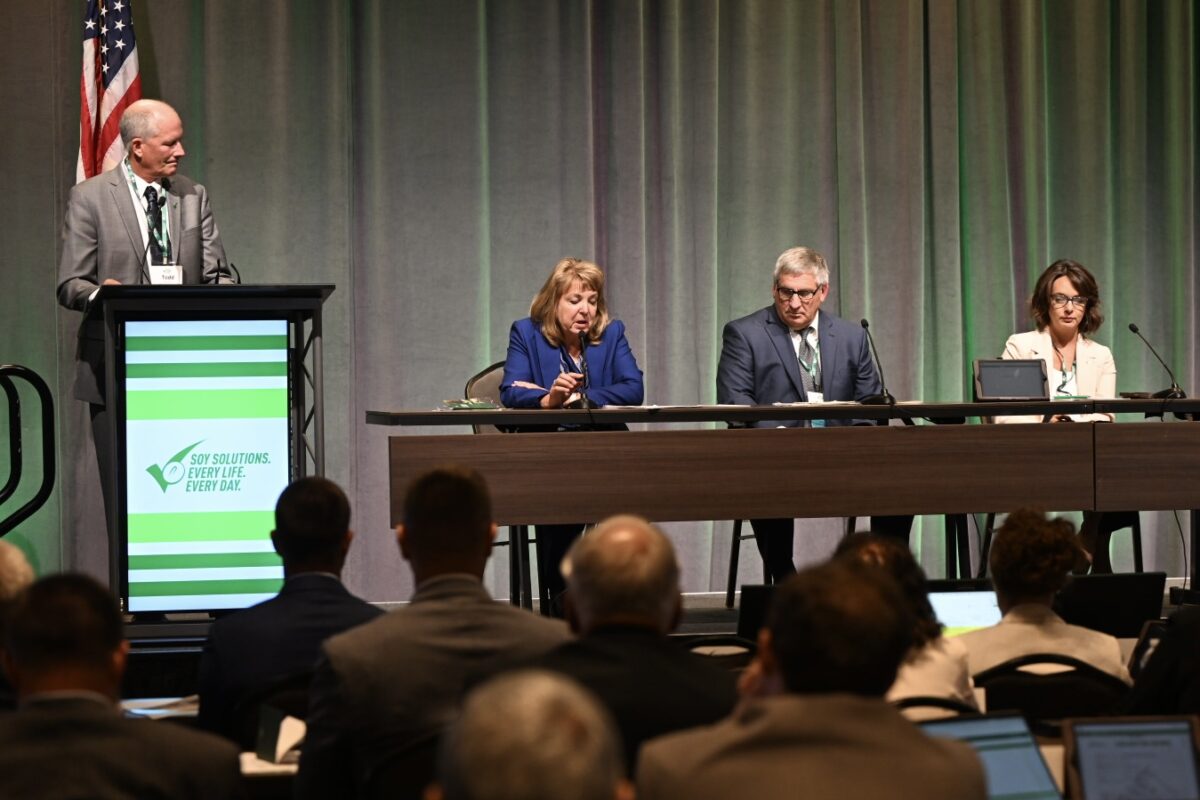Farming for the Generations

Farming is a family affair; in fact, nearly 99% of U.S. farms are family farms. And those families work 90% of the land and are responsible for 89% of farm production, according to USDA. The soy checkoff’s farmer-leaders walk that farmland every day.
The United Soybean Board’s 78 farmer-leaders come from all types of farms — from varying generations to commodities grown and animals raised, geography and more. But they all have one thing in common: their passion for farming and the families behind them.
Taking the First Steps
Many farms also include first-generation farmers — more than 20%, according to Farm Bureau Fast Facts About Agriculture, just like Tom Griffiths of Indiana and John Harrell of Pennsylvania. Yet their passion for farming agriculture is not new, but rather instilled in them by their families.
Although Griffiths grew up on a family farm, the family sold the operation before he was an adult. Griffiths thinks there is no better place to raise a family than on a farm. Because of this, Griffiths and his wife, Kim, decided that when they were going to have children, they would not raise them in town. Griffiths bought his first farm around the time his son Glen was born.
“There’s a big difference between being a first-generation farmer and a successful first-generation farmer,” says Griffiths. “It is about profitability and sustainability. If you’re not profitable and sustainable, you’re not in this business for very long.”
Griffiths has faced his fair share of challenges being a first-generation farmer. He says one of the most challenging parts was starting from scratch.
“They always talk about taking your time and making wise decisions. That was compounded for me. I was not allowed to make a mistake,” Griffiths says about the early days on his farm without other family members involved in the business. “Anything I did — whether it was planting, buying, remodeling, building — I made sure I had the finances for. Regardless of what that crop might be worth, I was covered.”
Despite the difficulties, his passion for farming has kept him making wise decisions for 31 years.
Like Griffiths, Harrell found his passion for agriculture early.
“I had the opportunity to work on a farm between the ages of 12 and 18, and I fell in love with farming,” says Harrell.
For Harrell, being a first-generation farmer is all about loving what he is doing. Each year this way of life brings different challenges, and he thoroughly enjoys overcoming them. Through trial and error and thinking outside the box in his work, Harrell is building a foundation for his family.
Because Harrell sees a future for the farm that extends beyond himself, he works hard to be sustainable. He stewards the land and the operation, hoping one day his daughter Alayna will become the second generation to run the farm. Harrell sees himself as developing a farm that could someday be multi-generational.
“I can’t see why anyone would not want to do it,” he says.
Meeting in the Middle
Farmer-leader and commodity crop farmer Belinda Burrier in Maryland and her husband are transitioning the family farm to the next generation, their daughter and her family. This transition is very much a hands-on learning experience. To Burrier, a successful transition involves answering many questions and teaching as many lessons as possible.
The Burrier family is like many other U.S. farms, according to a Farm Journal Pulse cited by Ag Web. Most farms include at least two or three generations of family members who are actively involved in the farming operation.
For this family, the transition began three years ago and started as a partnership. This arrangement allows the next generation to build equity and learn the business. Burrier and her husband help them, and in return, they help them back.
“We are teaching them how to market their grain and make good buys on chemicals and fertilizers, that kind of thing,” Burrier says.
In the future, she hopes there are fewer hard questions, especially as the final transition takes place because the family has answered those questions during the transition time. When the transition is over, she hopes she and her husband have set the next generation up for success.
“The ultimate goal is they would have enough equity to go ahead and buy a farm and to sell all of their market animals,” Burrier says. “I really think that’ll show signs of success.”
Walking in Someone Else’s Shoes
David Iverson of South Dakota and Garrett Marsh of Louisiana are farmer-leaders who both farm land that has been in their families for generations.
Over 110 years ago, Iverson’s great-grandfather moved to the current location of his farm, and it has been a family business ever since. While Iverson is the sole operator, his father still assists.
“It’s been a blessing to have the opportunity to farm,” says Iverson.
Farming is important to him for two reasons. First, he thoroughly enjoys the work. He likes planting and nurturing a crop to harvest. Additionally, Iverson takes pride in providing food, fiber and fuel for the world.
Of course, a farm that’s existed for more than a century has seen numerous changes, but Iverson has also seen a lot of change in just his time on the farm.
“In my career, the technology aspect has changed tremendously,” says Iverson. “With this change in technology, it has made it easier on the generations and more enjoyable.”
With any change, he says there is always a potential for a lot of challenges. Iverson says with multiple generations working the operation, “You have to work together to mold what the goals are and what the ideas are.”
Marsh also values the long-standing togetherness his family farm provides. The farm began with his grandfather and his family, who passed it down to his five sons: Marsh’s dad and four uncles.
“You think about five brothers working together and getting along — that’s a pretty good feat for them,” says Marsh. “Seeing that encouraged my family to be on the farm a lot.”
For Marsh, to be the third generation in his family to farm is humbling.
“Farming has been in our family for that long,” says Marsh. “It’s amazing to me that our whole family all went off, went to college and different things, and ultimately ended up back farming again.”
And as generations continue to farm, the operations continue to evolve. “Now we have GPS technology and self-driving technologies,” says Marsh. He adds that in the future, there will be new technologies and ideas we have never thought about.
Walking the Path
In farming, there are many lessons to be learned, regardless if you are a first-generation farmer just starting, farming during a transition time or working land that has been in your family for generations.
Hopefully, those lessons keep the operations sustainable and profitable, so farming remains a family affair.
“There is no other career that allows you to get up at the break of dawn and watch the sunrise while spending your day caring for the land and animals,” concludes Marsh.



